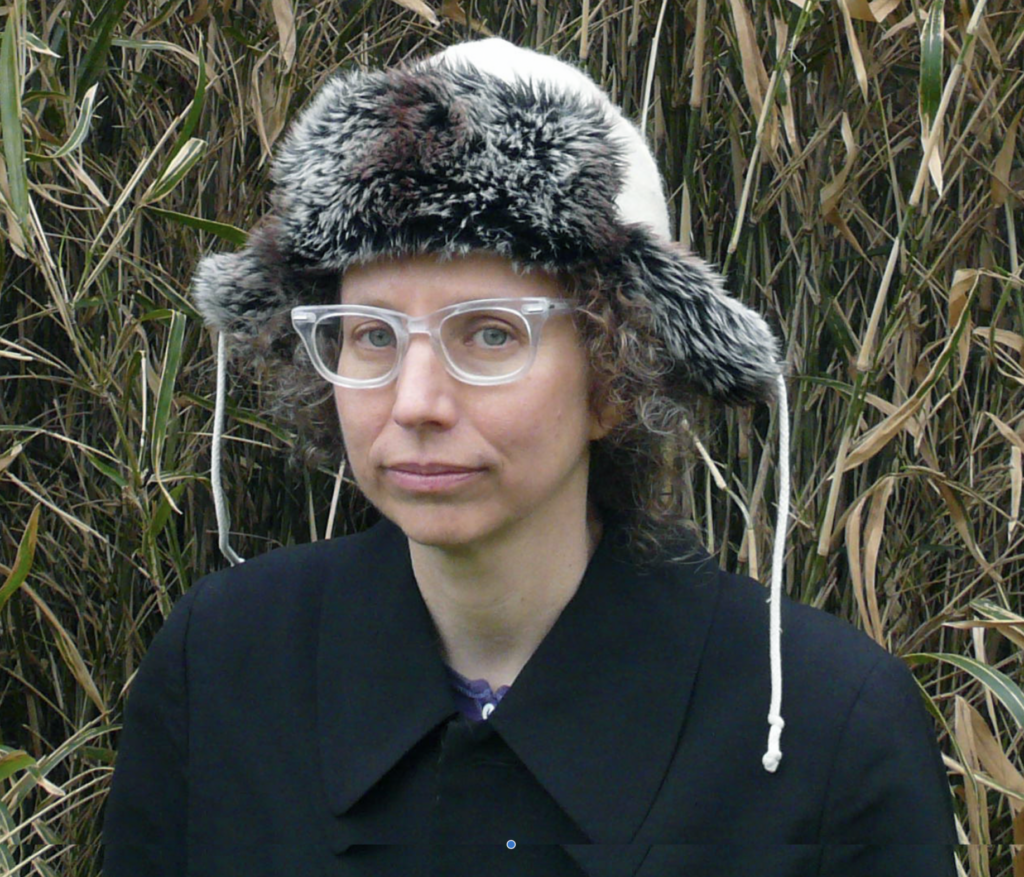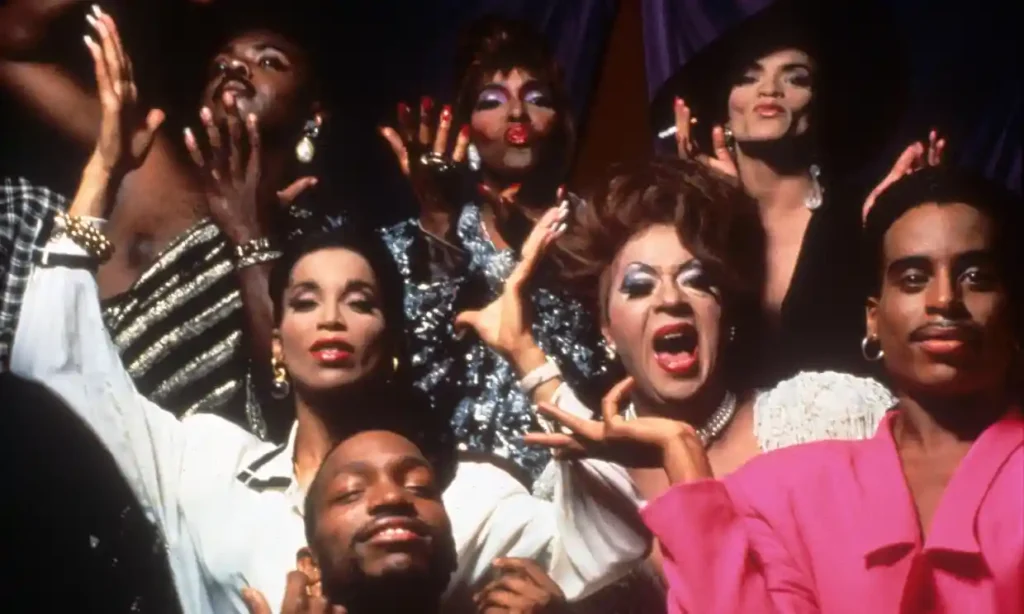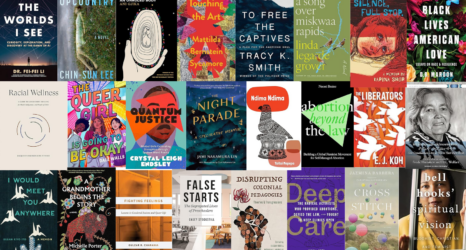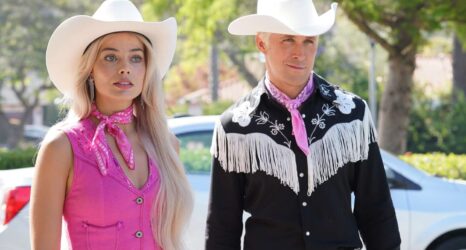
When filmmaker Jennie Livingston stumbled upon drag ball culture in the late 1980s, they had no idea how much the resulting film would resonate. Released in 1990, Livingston’s first documentary Paris Is Burning showcases drag balls during the late 1980s in Harlem, New York City and features interviews with numerous queer and trans Black and Latinx performers who comprised the various “houses” in competition at the balls.
The timing couldn’t have been more perfect. In 1989, Kimberlé Crenshaw had coined the phrase “intersectionality” to highlight how an individual can be oppressed via numerous distinct identities (e.g. gender, race, sexuality). And in 1990, Judith Butler published the book Gender Trouble, arguing that there is no “original” gender or sexuality—there are merely copies of copies of copies. Within a few years, Paris Is Burning would become the subject of abundant scholarly discussion and debate with leaders like bell hooks, Ruby Rich, Jack Halberstam, and others weighing in.
Decades later, the film continues to resonate. In 2016, it was accepted into the National Film Registry at the U.S. Library of Congress. In 2020, the Criterion Collection acquired and restored the film for redistribution. And since its 2021 opening, the newly opened Academy Museum of Motion Pictures has featured an excerpt of the film in its exhibitions. Paris Is Burning is not just an essential record of drag life before drag was part of the U.S. mainstream, it continues to spark debate and inspire offshoots—such as RuPaul’s Drag Race and Pose.
In this interview with Ms. writer Michele Meek, Livingston talks about the legacy of the film and their latest work.
Michele Meek: I can’t help but notice how the drag competitions in Paris Is Burning emphasize “realness,” which feels more problematic today in light of how the ideal of “passing” has come to be critiqued. Did that feel like an issue at the time?
Jennie Livingston: I don’t know about balls now, but I feel like in the past there were plenty of spaces for people who didn’t care at all about “realness.” In Paris Is Burning, there are a lot of categories where it wasn’t a factor: Butch Queens First Time in Drag at a Ball was actually a category that made fun of realness. Voguing categories weren’t about passing or about conforming to a binary, but about dance skill. Categories for big bodies, or punk or futurist categories… all of those welcomed creativity that wasn’t about passing or conforming to a binary.
The 80s drag queens like Avis Pendavis and Pepper and Dorian and Paris who created showgirl pageant-type performances really weren’t particularly into realness… they were into lots of fabric and feathers. None of those “house mothers” were realness queens: they were (in the ballroom, and in Dorian and Paris’s case, outside of it) performers! But…for sure the realness categories, particularly for the girls, was about loving and applauding how particular trans women so successfully crossed from one side of the binary to the other and often embodied very conventionally alluring ways of being feminine and female. And for sure queens or trans women who weren’t able to do that were at a disadvantage. As Dorian points out…because they’d get attacked. In the ballroom, the judges and the spectators could be mean. But I think people chose their categories, and learned to dance, or to sew, because they knew they couldn’t compete in “face” or “realness.”

Meek: At one point in the film, Corey even describes “realness” as “going back into the closet.” Is this how you saw it then?
Livingston: I think my whole point… point is maybe the wrong word because I wasn’t really trying to make any points, but my feeling was so visceral.
I’m a night person so I always loved that balls were supposed to start at midnight, but they really didn’t start till 3 in the morning. So I would go to these events, and the events would get out at noon. And at noon on Sunday, you would see the drag queens out in the street after the ball and the church ladies going to church. And the church ladies had the hats, and the drag queens had the drag queen finery. And I just began to have this visceral feeling about the construction of gender.
I had never felt comfortable with gender, with the system. I wanted to be a little boy when I was little, then I was a queer, and there was more room, but I just didn’t get it. I never felt like a woman. I didn’t really want to be a man. Feminism made so much sense to me, and queer culture made so much sense to me, but I just didn’t get it.
And so it’s not that the binary wasn’t often reinforced in the ball world, but there was the sense that you could mess with a binary. You could trick it, and no one would know.
At noon on Sunday, you would see the drag queens out in the street after the ball and the church ladies going to church. And the church ladies had the hats, and the drag queens had the drag queen finery. And I just began to have this visceral feeling about the construction of gender.
Jennie Livingston
Meek: Did you find that the series Pose presented the world of Paris Is Burning authentically?
Livingston: The Pose episode that I directed, which was written by Janet Mock, I thought was one of the best Pose scripts. I was so happy I got to direct this episode. But there were things that were inauthentic in the series. I mean Pose was not concerning itself with historical accuracy—it concerned itself with feeling and pageantry and empathy, but not with reflecting certain details of life at that time. For example, in the episode where a straight white character with a trans lover visits the ballroom; and another ballgoer sees he’s uncomfortable and gives him a hard time. That wasn’t how it was. The ballroom was a party, and people were welcoming and hospitable; there was no internet, so if you got there and paid your fee at the door (another detail the series left out!) you must have known someone. And everyone was welcome.
In the episode that I directed, the kids from the ball world meet some ACT UP activists and they end up doing an ACT UP action, modeled directly after when the group TAG put a giant condom on Jesse Helms’ house. We had so much fun, filming a giant condom on a house. I got to use a big crane and film the giant condom on that. I mean, it was a great visual joke to play with.
But, even though I didn’t know every ball person, and I didn’t know every ACT UP person, ball kids and ACT UP working together: it was a fun fantasy, but it really wouldn’t have happened. And I was at the balls a lot. And I was at ACT UP a lot. I don’t think there was any crossover because the ACT UP activists, we were Ivy educated, super entitled, not all exclusively white, but many were white. And many of us were convinced that if we fought hard enough, we could get the drug companies and the government to cure AIDS.
There was nothing like that level of privilege in the ball world. The ball world was like, I want a place where I can be safe to be me. It was a refuge, a social refuge. I’m not saying there weren’t African-American and Latinx people who were AIDS and social justice activists. But the ball world of that time was about walking and winning a trophy. It was about fashion and beauty. It was about visual creativity and dance. Definitely not an activist mindset.
And I think there’s nothing wrong with poetic license, but there are shows that want to do a deep dive to create storylines where someone who’d been there would say, “Yes, that’s just how it was!” Pose was more about a feeling, and about being, as one of the producers said to me one day, more “pop.”
Meek: This connects to one of the questions the film has raised over why those who were immersed in the ball world did not or could not make a film to tell their own story back in the 1980s. What are your thoughts now on why not?
Livingston: I think that film has been the province of very educated, privileged people because huge swaths of money are involved. It’s been only accessible to people who either have money or know how to represent that they can be trusted with large sums of money. That’s why the industry has been so slow to let women and BIPOC people in. There’s a perception about who should have the money and who should decide what to do with it.
And I mean, I think even today when “everyone has an iPhone,” still the technical know-how and the knowledge of structure and knowledge of film history cannot be acquired easily. At the time I made Paris Is Burning, there just wasn’t even a sense that someone who came from the ball community should be making a film. I mean, it just wasn’t happening.
They weren’t making films because there weren’t enough resources, enough education, and enough sense that you should be able to make a film about your own community or experiences. And that’s completely changed. I mean, there are definitely ball people now or people who were ball-adjacent who are making films, who are getting deals, who are telling their stories or telling the stories they want to tell.
That’s really shifted. And it’s happened quickly, but it hasn’t happened systemically. It’s the same stats really as it was back then. There’s token here-and-there changes, but systemically there is not an all-pervasive inclusiveness and equity happening in the film and television world.
I take a lot of heart from a lot of the dialogue from BIPOC filmmakers now, particularly Black filmmakers because they say things that I tried to say and was not allowed to say, like, if I said them, I was whining or had a chip on my shoulder. I mean, Spike Lee would talk that way, but the dialogue now has advanced to where people feel empowered to speak. On NPR I heard a Black filmmaker saying how he goes in with a script that clearly needs 1.5 million and they offer 300,000. And that’s totally gaslighting because they’re saying do this thing, but they know you can’t do it. And that happened to me too.
Meek: How do you think it changes stories to have people telling them from within those communities?
Livingston: I mean a show like Reservation Dogs, which I really liked so much, is just few and far between. Its strength comes from the fact that somebody said this show will be created by for and about Indigenous people on a reservation. And so it shines with … it’s not just authenticity. It’s like you’re allowing the writers to have a sense of humor and a sense of politics and a sense of irreverence. They get to be irreverent about themselves and their community in a way that it would be impossible for an outsider to get right.
Meek: Well, on that note—tell me about your next project!
Livingston: The working title is Earth Camp One—and it’s basically about how I lost four family members in five years. And it’s about living through that.
The title refers to a hippie summer camp I went to in the seventies, a connection being that when you’re young, you often want to break away from your family and find different cultural markers. But what happens when they leave you? So that was my starting point. It is about impermanence. It is about loss, but it’s also about how as artists, a lot of the way we walk through the world is to see it. And you know, when you’re in a family where you don’t quite fit, how do you find yourself?
Up next:





